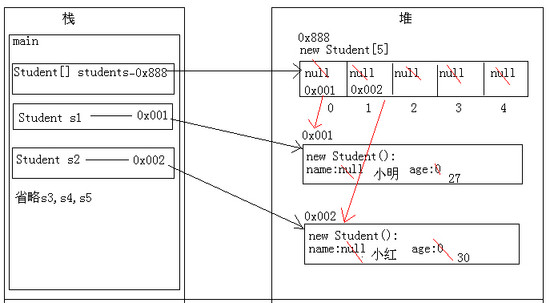数组小伙伴们都接触过了,那对象数组是什么意思小伙伴们知道吗?它又该怎么实现呢?下面就一起看看吧。
对象数组概念及实现
public class Student
// 成员变量
private String name;
private int age;
// 构造方法
public Student()
{
super();
}
public Student(String name, int age)
{
super();
this.name = name;
this.age = age;
}
// 成员方法
// getXxx()/setXxx()
public String getName()
{
return name;
}
public void setName(String name)
{
this.name = name;
}
public int getAge()
{
return age;
}
public void setAge(int age)
{
this.age = age;
}
@Override
public String toString()
{
return "Student [name=" + name + ", age=" + age + "]";
}
}/**
把5个学生的信息存储到数组中,并遍历数组,获取得到每一个学生信息。
* 学生:Student
* 成员变量:name,age
* 构造方法:无参,带参
* 成员方法:getXxx()/setXxx()
* 分析:
* A:创建学生类。
* B:创建学生数组(对象数组)。
* C:创建5个学生对象,并赋值。
* D:把C步骤的元素,放到数组中。
* E:遍历学生数组。
* */
public class Practice
{
public static void main(String[] args)
{
// 创建学生数组(对象数组)。
Student[] students = new Student[5];
// for (int x = 0; x < students.length; x++)
// {
// System.out.println(students[x]);
// }
// System.out.println("---------------------");
// 创建5个学生对象,并赋值。
Student s1 = new Student("小明", 27);
Student s2 = new Student("小红", 30);
Student s3 = new Student("小强", 30);
Student s4 = new Student("旺财", 12);
Student s5 = new Student("张三", 35);
// 将对象放到数组中。
students[0] = s1;
students[1] = s2;
students[2] = s3;
students[3] = s4;
students[4] = s5;
// 遍历
for (int x = 0; x < students.length; x++)
{
//System.out.println(students[x]);
Student s = students[x];
System.out.println(s.getName() + "---" + s.getAge());
}
}
}对象数组内存图解

以上就是今天的所有内容,对于数组小伙伴们如果还有疑问,并且想了解更多java项目中常见问题,就快一直关注我们网站吧。
推荐阅读:
